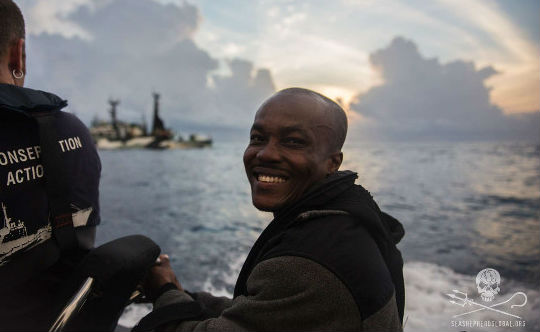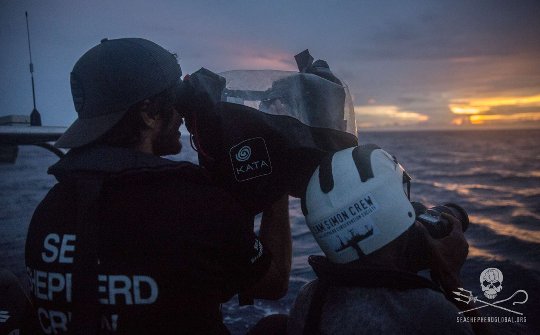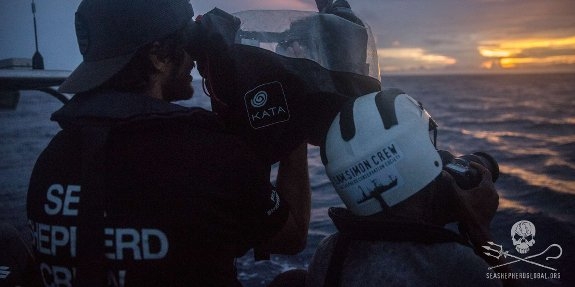A Ghanaian photographer joined the hunt for a ‘most wanted’ pirate fishing ship
Crime, exploitation, fish poaching and other forms of piracy pervade the high seas. Ghanaian photographer Selase Kove-Seyram joined a New York Times reporting project on this and found himself chasing a mammoth pirate fishing ship on rather wobbly legs.
Standing on the deck of a 400-foot ship, hundreds of miles from the West African coast in the South Atlantic Ocean, I looked over at Ian Urbina, the New York Times reporter I had joined on this assignment. He smiled at me and said ‘Game day.’
I knew exactly what he meant. We were about to hunt the hunters, the poachers of fish aboard a rusty mammoth ship high on Interpol’s most wanted list; poachers that deplete fish stocks and rob countries –like my country, Ghana- of their marine resources. Thunder, was the name of the ship we were after. We were chasing Thunder.

‘Our’ ship was called the Sam Simon. It is an old Japanese weather survey ship, one of two ships purchased by the international environmental activist group ‘Sea Shepherd’ to track down and chase illegal fishing vessels like the Thunder. It was our third day of work. The sun was setting. We were finally close enough within range to photograph the poachers’ ship.
Africa’s fish
I had jumped at the opportunity to work as a photographer alongside Urbina, who has been an investigative reporter with the Times for over a decade and has covered everything from arms deals, the oil and gas industry and workers’ struggles. I had joined him at the tail end of his ‘Lawlessness on the Oceans’ project that took him a year and a half to report, spanned ten countries, and portrayed the often criminal environment on the high seas. He had seen piracy, human trafficking and real slavery; had investigated environmental crime as well as murder of stowaway. (See this link for the entire New York Times series.)
This sprawling and complicated subject should also carry distinct resonance for the African continent. Few places in the world have more interest in the sea than Africa. Annually, the continent loses over US$1 billion because foreign vessels poach fish from national waters. Fishing is one of the continent's major sources of revenue, there being more than twelve million African fishermen. Piracy and other forms of maritime violence remain a major financial drain and source of instability. Poverty and war cause tens of thousands of people each year to flee Africa, sneaking onto ships as stowaways or brokered by human traffickers -- and their fate at sea is often brutal and deadly.
The continent loses US$ 1 billion annually to fish poaching
The Thunder had been poaching millions of dollars of fish worth for more than a decade. It had avoided capture by law enforcement all this time. Now, an environmental advocacy group called Sea Shepherd had spotted it in Antarctica and had moved to tail it. Off the coast of Ghana, we had joined what was, by then already, already the longest sea chase in history -of over 14 000 miles in total.
Wobbly filming
Getting to the ship had been a bit of an ordeal though. We had raced against the clock because we needed to be far out to sea by a certain date, or we would miss our chance to board the ‘Sam Simon.’ We had first hitched a ride on a port patrol cutter, but that didn’t go well. On its way out, the 40-foot boat had hit relatively heavy seas and bounced around like a bathtub toy. Hiding from the elements by going below deck had hardly been better. There was a leak and the fumes from the burning bunker fuel seeped in and the already hot, small, tipsy space became acrid and dizzying. The combined effect made me intensely sea sick for fourteen long, awful hours. The port patrol crew, equally unused to the high seas, didn’t feel much better. They eventually decided to turn back and return us to shore, deeming it unsafe to continue.

I had never been to sea before
The next day, with the help of a cargo ship, we finally managed to meet up with the Sam Simon. After picking us up, the ship sprinted toward the equator trying to catch up with the Thunder. I was struggling to get still photographs as well as video, since toggling the two mediums required some dexterity; particularly when the ground beneath my feet was rather wobbly. I had never been to sea before and found that much focus was required to manage the unstable deck. Also, at sea, the waves crash at will and the wind blows unusually hard, since nothing stands in its way. Looking through a camera eyehole tests your balance as it is. Having the floor swaying under your feet, one easily topples over.
Oh, and I can’t swim.
Getting the picture
We needed to get near enough to the Thunder for the video and photographs to work. So we climbed down into small, fast rubber skiffs that could move us within a couple hundred feet of our target. Fortunately the weather was perfect and the light was just right. But we were wary of other risks. Only several weeks earlier, the crew of the Thunder had thrown chains and bottles at the passengers of this same skiff when it had approached.
Switching between lenses, I shot as many angles as I could muster. We circled the Thunder repeatedly before we finally decided to head back. On our way back to the Sam Simon however, we got a radio call alerting us to move again in the direction of the Thunder. It seemed that suddenly, there was a cluster of something jumping out of the water on the horizon. "Might just be fish," the Sam Simon's captain said. "But go check it out." We headed back.
The crew of the Thunder had come outside to look at the dolphins, too
They were dolphins. Hundreds of them. It was like nothing I had ever seen, not even on television. For the next half hour our skiff ran parallel with the Thunder but now the focus momentarily wasn’t on that ship. Enthralled by the sight, we just watched the animals jumping from the water in the several hundred feet between our boats. Then, suddenly, we noticed that the crew of the Thunder had come outside to look at the dolphins, too.
It was the strangest twist of luck: these men whom we had not been able to photograph, wanted criminals, men whose identities even Interpol had not pinned down, stepped into our line of shot. I couldn't grab my zoom lens fast enough. It was one of those rare moments in this job when it all falls in place.
Epilogue
The Thunder, in the end, sank off the coast of Sao Tome island. The Sea Shepherd crew suspected that it was sunk deliberately by its own crew because its hunters were coming too close. (Read the full story of the ‘Hunt for the Thunder’ by Ian Urbina here and Ian Urbina’s ‘Reporter’s notebook’ here.)
Selase Kove-Seyram is a multi-media producer and free-lance journalist based in Ghana.


